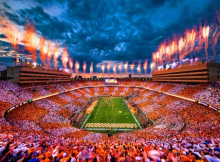
North of Fort Sanders, at the intersection of Grand Avenue and Dale Avenue, previously stood Baldwin Park, the home field of the Tennessee Volunteers football team.Wait Field, where the Walters Life Science Building now sits, served as the team’s home field from 1908 to 1920.
The stadium’s original design dates back to 1919. The first funding for preparing and equipping an athletic field came from Colonel W.S. Shields, a trustee of the University of Tennessee and president of Knoxville’s City National Bank. Shields–Watkins Field was thus named in honor of the benefactor and his wife, Alice Watkins-Shields, when the old stadium, which is the lower level of the current stadium’s West Stands, was finished in March 1921.
The project, however, ran out of money and was put on hold until MacGregor Smith proposed, during a meeting of the Scarabbean Senior Society at the university, that staff and students collaborate to complete the project in the middle of 1921. Students and instructors completed the field across two days at the group’s request. As a celebration, an invitational track meet was subsequently held, which turned into Neyland Stadium’s inaugural event.
The stadium was renamed Neyland Stadium in 1962 in memory of the recently dead former coach and athletic director, General Robert Neyland. With two pauses for military duty, Neyland led the Vols from 1926 to 1952—the period during which he is recognized as having established the team as a national football powerhouse. One of the earliest stadiums with an AstroTurf field was this one, built in 1968.









